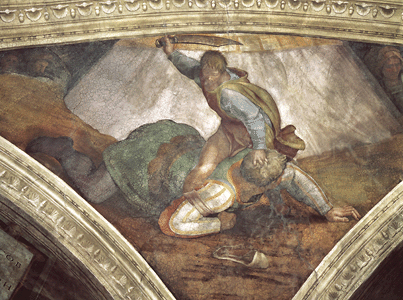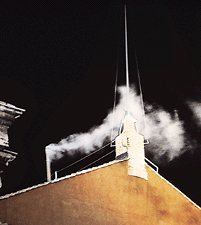The Conclave Begins
Wednesday, March 13th, 2013March 13, 2013

Cardinals vote beneath the painted ceiling of the Sistine Chapel, completed by Michelangelo between 1508 and 1512. (Detail of a fresco (1509); SCALA/Art Resource)
Cardinals of the Roman Catholic Church entered the Sistine Chapel in Vatican City, yesterday to begin the conclave—the process of voting for a new pontiff, or pope. The word conclave is from the Latin for a room that may be locked. After a special mass, the monsignor running the conclave announces “Extra omens,” Latin for Everyone out. The voting cardinals are then locked into the Sistine Chapel. Cardinals have attended the conclave in the Sistine Chapel since 1492.
Of the more than 200 men in the College of Cardinals, the group that votes for a new pope, only 115 were eligible to vote in 2013. Cardinals who were age 80 or older on the day that Pope Benedict XVI resigned, February 28, 2013, may not vote in the conclave.
Before they enter the conclave, the cardinals swear an oath of secrecy about the proceedings. Cardinals caught breaking the oath are excommunicated. In addition, in 2013, the chapel was carefully checked for listening devices and devices that jam electronic communication were installed.
In 1268, cardinals took nearly three years before finally choosing Gregory X as pope. Since the early 1900′s, however, no conclave has lasted more than a few days.
After the first day of the conclave, the cardinals vote four times per day until two-thirds of them have agreed on a candidate. The vote is taken on paper ballots, and after the ballots are counted they are burned. The smoke rising from the chimney of the chapel indicates to the outside world whether a new pope has been chosen. Chemicals are added to the ballots to make the smoke appear black or white. Black smoke indicates that no candidate won the election. White smoke issued from the chimney announces the election of a new pope.

The election of a pope is announced to the outside world by white smoke emerging from a chimney atop the Sistine Chapel. (Francois Lochon, Gamma/Liaison)
Once a pope is chosen, he has a little time to pray and choose his new name. Then, he dons his new robes. Because the papal tailors do not know who will next wear these robes, they provide a complete set of clothing and shoes in different sizes.
When the pope is ready, he makes his first appearance to the world from the balcony of St. Peter’s Basilica.
Additional World Book articles:
Another website of interest:


